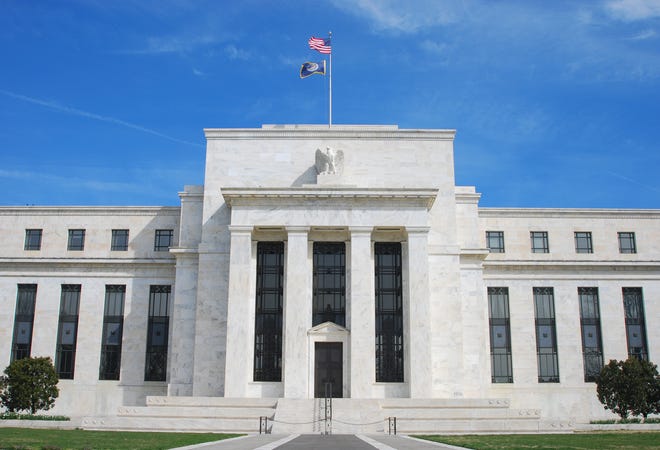
The resilient economy was doing nothing to convince the Federal Reserve to halt its aggressive interest rate hikes aimed at taming inflation.
A wobbly U.S. financial system may well do the trick.
Top economists say the collapse of Silicon Valley Bank (SVB) and broader risks to the financial system will lead the Fed to raise interest rates by no more than a quarter percentage point next week and some experts expect the central bank to pause.
Markets had been pricing in a half point rate increase after two developments last week — Fed Chair Jerome Powell’s Congressional testimony and a generally strong employment report showing 311,000 job gains. February inflation data, due out Tuesday, was expected to be the deciding factor between a quarter and half-point move, with the latter gaining favor amid forecasts of another swift rise in consumer prices.
Things have changed.
“Inflation is no longer the sole focus for the Federal Reserve,” says Kathy Bostjancic, chief economist of Nationwide Mutual.
Will more banks fail?:Silicon Valley Bank, Signature Bank failures explained, live updates on new developments
Biden assures consumers:Banking crisis: President Joe Biden says taxpayer money won’t be used to bail out SVB, Signature Bank
Live updates:The latest developments following SVB’s collapse
Could the Fed pause rate hikes?
Nationwide, Goldman Sachs, Barclays and, NatWest are among research firms that are predicting the Fed will keep rates unchanged or are at least leaning toward that forecast.
“In light of recent stress in the banking system, we no longer expect the (Fed) to deliver a rate hike at its March 22 meeting with considerable uncertainty about the path beyond March,” Goldman Sachs wrote Sunday in a note to clients.
For now, Goldman still expects quarter point rate increases in May, June and July, bringing the Fed’s key short-term rate to a range of 5.25% to 5.5% — a quarter point below its prior estimate.
Barclays reckons the Fed will likely hold rates steady next week, though it adds a quarter point move is possible. It expects the central bank to pause after reaching a peak rate of 5% to 5.25%, a half point below its earlier projection.
Kevin Cummins, chief U.S. economist of NatWest, is going further. He thinks the Fed will keep rates unchanged next week and figures it’s likely done hiking after the most aggressive flurry of increases since the early 1980s. The Fed’s key rate is at 4.5% to 4.75%, up from near zero a year ago.

“I think in response to the uncertainty and financial stability concerns they’ve got to be really cautious going forward,” Cummins says.
What did the government do to eliminate bank runs?
On Sunday, the Fed, the Treasury Department and the Federal Deposit Insurance Corporation moved to settle markets by announcing funding to allow all depositors of Silicon Valley Bank and Signature Bank to access all their cash, not just the $250,000 insured by FDIC.
Regulators also said they were making loans available to other institutions so depositors can access all their cash in the event of similar bank runs.
But Bostjancic says many regional banks may be reluctant to draw on those loans because of the stigma that could brand them as troubled, leading more depositors to withdraw their money. Even with the loans, many depositors could try to move their cash from riskier regional banks to larger banks, causing the regionals to curtail lending and possibly become insolvent, says Barclays economist Jonathan Millar.
Amid the uncertainty, share prices of regional banks plunged Monday, further stoking concerns about their survival.
The crisis is also likely to make banks less likely to approve loans, further damping consumer and business confidence and the economy, Bostjancic and Cummins say. That’s another reason the Fed could hoist rates more gradually or take a break, they say.
What caused Silicon Valley Bank to collapse?
The crisis began when SVB depositors, largely tech start-ups, began withdrawing their money to cover operating costs as venture capital funding dried up. SVB was forced to sell bonds that had tumbled in value because of the Fed rate increases, raising concerns about its solvency and intensifying the bank run.
Analysts say SVB was in a unique predicament because of its tech-heavy client base and large share of assets in investments, particularly bonds, rather than loans. But the meltdown sparked fears of similar runs at other regional banks.
Will the Fed continue to raise rates?
EY-Parthenon and Oxford Economics are among research firms that still expect the Fed to follow through with a quarter point rate increase next week, especially if markets, and worries about the regional banks calm in coming days.
Last fall, the Bank of England intervened in a UK pension crisis by buying bonds but still approved a three-quarter point rate increase, says Gregory Daco, chief economist of EY-Parthenon.
“Risking a loss in the battle against inflation is not something Fed Chair Powell wants to do,” Daco wrote in a note to clients. Tuesday’s inflation report “may still play a defining role” in the Fed’s decision.
He added that even a half point increase is still possible.
In other words, expect more market drama. Typically, Fed officials signal their interest rate plans before meeting but they’re now in a quiet period and barred from communicating with the public. That, along with “the elevated degree of market uncertainty…will make for a volatile period,” Daco says.






